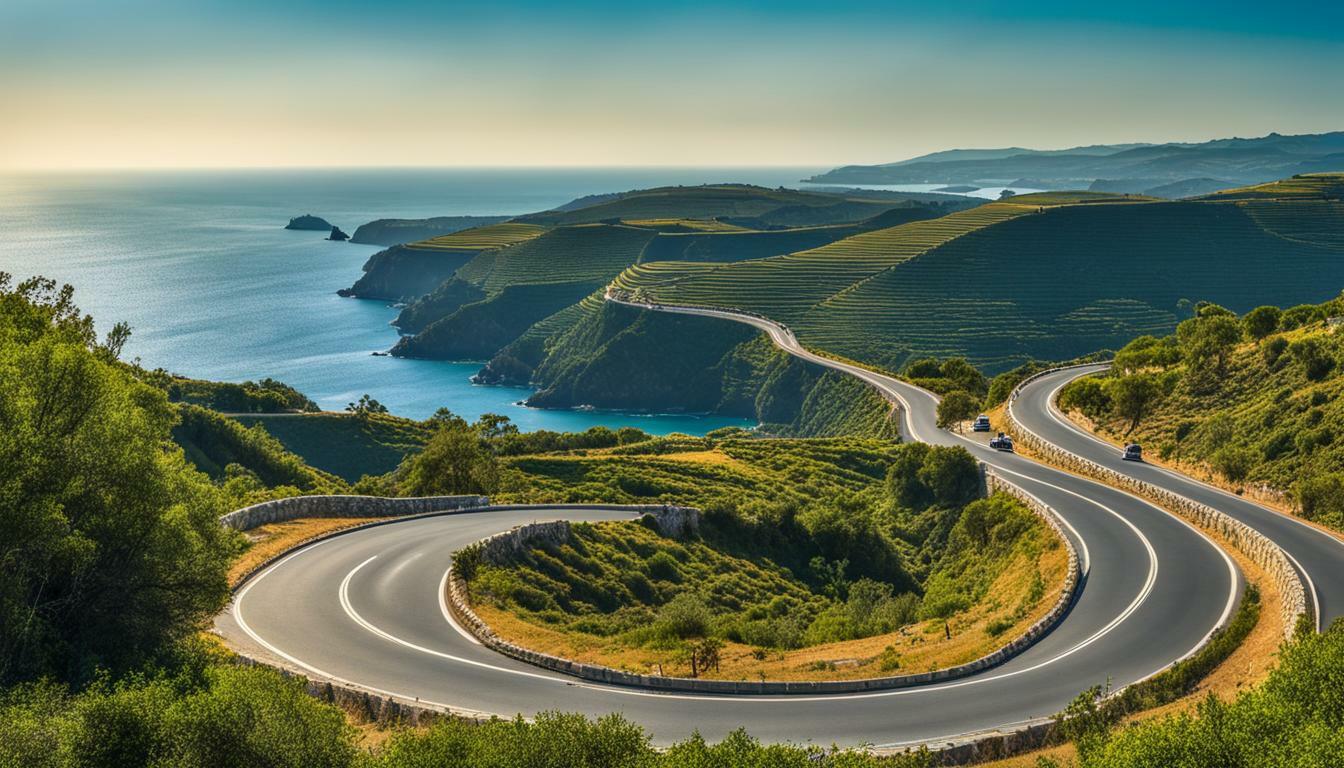Driving in Portugal
Driving in Portugal can be a rewarding experience, but it's important to be prepared and aware of the rules of the road. Portuguese drivers are known for their impatience and a tendency to not use turn signals, which can create challenges for drivers. However, with proper preparation and knowledge, you can navigate the roads of Portugal safely and enjoyably.
Key Takeaways:
- Make sure you have a valid driving license, and if you're from the United States or an EU nation, you can drive in Portugal with your local license.
- Consider obtaining an International Driving Permit, which is translated into Portuguese, to enhance your driving experience and provide added security.
- Keep important documents in your car, including your original license, IDP if applicable, passport, car documents, and proof of insurance.
- Adhere to the rules of the road, such as driving on the right, overtaking on the left, stopping at stop signs, and not crossing white lines.
- Familiarize yourself with the speed limits, which are in kilometers per hour, and the low alcohol limits. Designate a non-drinking driver if consuming alcohol.
Portugal Driving Laws and Road Rules
Understanding the driving laws and road rules in Portugal is essential for a safe and enjoyable journey. Whether you're a local or a visitor, it's important to know the regulations and requirements to ensure a smooth experience on the roads.
First and foremost, it is necessary to have a valid driving license. If you're an American or an EU national, you can drive in Portugal with your local license. However, it is highly recommended to obtain an International Driving Permit (IDP) for added security. The IDP is translated into Portuguese and can be obtained through your local automobile association.
In addition to your license, you should have the necessary documents in your car. These include the original license, IDP (if applicable), passport, car documents, and proof of insurance. By law, Portuguese drivers are required to carry safety items in their vehicles, such as a high-visibility jacket, reflective warning triangle, and child seat. These items are essential for your safety and compliance with regulations.
| Road Rule | Requirement |
|---|---|
| Driving side | Right-hand side |
| Overtaking | On the left |
| Stop signs | Full stop required |
| Alcohol limits | Low limits; designate a non-drinking driver if consuming alcohol |
| Speed limits | In kilometers per hour; be aware of the limits and adjust your speed accordingly |
When renting a car in Portugal, it is crucial to check the requirements of the rental company and thoroughly inspect the vehicle before leaving. While most roads in Portugal are in good condition, driving in the countryside can be more challenging, especially on narrow and steep mountain roads. Additionally, rural areas may have pedestrians, livestock, and parked cars along the roads, so it's important to remain cautious.
In case of emergencies or breakdowns, the emergency number in Portugal is 112. You can also call for roadside assistance for help. Alternatively, public transport in Portugal is reliable and inexpensive, offering trams, trains, buses, and taxis as convenient options. For those looking for a greener mode of transportation, cycling is popular in Portugal, with dedicated bike lanes in cities and bike paths in rural areas.
Road Signs and Speed Limits in Portugal
Familiarizing yourself with the road signs and speed limits in Portugal will help you navigate the roads with confidence. Portuguese road signs are similar to those in other European countries, but understanding their meanings and following them is crucial for a safe driving experience.
Here are some key road signs you should be aware of:
| Sign | Description |
|---|---|
| No Passing: Indicates that overtaking is prohibited on the section of road ahead. It is important to adhere to this sign and not cross the white lines. | |
| Roundabout: Indicates the presence of a roundabout ahead. Roundabouts are common in Portugal, so understanding how to navigate them is essential. | |
| Speed Limit: Displays the maximum speed limit for the specific road. Speed limits in Portugal vary depending on the type of road, so pay attention to these signs to avoid fines and ensure safety. |
Speed limits in Portugal are generally as follows:
- Urban Areas: 50 km/h (31 mph)
- Rural Areas: 90 km/h (56 mph)
- Motorways: 120 km/h (75 mph)
It is important to note that these speed limits can change based on specific road conditions or regulatory signs, so always stay vigilant and adjust your speed accordingly.
Remember, road signs are there to guide and protect you. By understanding and following them, you can ensure a safe and enjoyable driving experience in Portugal.
Rental Cars and Driving Safety Tips in Portugal
Renting a car in Portugal opens up endless possibilities, but it's important to follow these tips for a smooth and safe journey. Before hitting the road, make sure to check the requirements of the rental company and thoroughly inspect the car. Look for any scratches, dents, or mechanical issues, and document them to avoid being held responsible later. It's also a good idea to familiarize yourself with the car's features, such as the location of the spare tire and the operation of the lights and windshield wipers.
Once you're on the road, keep in mind that Portuguese roads are generally in good condition. However, driving in the countryside can be more challenging, particularly on narrow and steep mountain roads. Be prepared to encounter pedestrians, livestock, and parked cars blocking the road in rural areas. It's important to stay alert and drive at a safe speed, especially when navigating sharp turns and steep inclines.
Table: Driving Safety Tips in Portugal
| Tips | Description |
|---|---|
| Observe Traffic Rules | Drive on the right and overtake on the left. Stop at stop signs and yield to pedestrians. |
| Maintain Speed Limits | Familiarize yourself with the speed limits, which are in kilometers per hour. Be cautious and adjust your driving speed accordingly. |
| Avoid Drinking and Driving | Portugal has low alcohol limits, so it's crucial to designate a non-drinking driver if consuming alcohol. |
| Be Aware of Rural Challenges | Exercise caution when driving in rural areas, as there may be unexpected obstacles like livestock, pedestrians, and parked cars. |
| Emergency Preparedness | Keep the emergency number in Portugal (112) handy and know how to summon roadside assistance if needed. |
In case of emergencies or breakdowns, remember that the emergency number in Portugal is 112. If you need assistance, you can also call roadside assistance, which is available throughout the country. Additionally, it's important to note that public transport in Portugal is reliable and inexpensive, making it a viable alternative to driving. Trams, trains, buses, and taxis are readily available, providing convenient options for exploring the country's cities and towns.
When it comes to alternative transportation, cycling is also a popular mode of getting around Portugal. Dedicated bike lanes can be found in cities, while bike paths traverse scenic rural areas. So, whether you choose to rent a car or opt for public transport, Portugal offers a range of transportation options to suit every traveler's needs.
Public Transport and Alternative Transportation in Portugal
If you prefer not to drive, Portugal offers a range of efficient and convenient public transportation options. The country has an extensive network of trams, trains, buses, and taxis, making it easy to get around without a car. Whether you are exploring the historic city centers or venturing into the countryside, public transport is a reliable and inexpensive way to travel.
One of the highlights of public transport in Portugal is the tram system. Trams are a popular mode of transportation in cities like Lisbon and Porto, allowing you to navigate the narrow streets and steep hills with ease. The trams are not only practical, but they also offer a unique experience, taking you past historic landmarks and scenic views. It's a great way to immerse yourself in the local culture while getting from one place to another.
If you prefer a faster and more extensive mode of transportation, the train network in Portugal is a great option. The trains connect major cities and towns, offering a comfortable and efficient way to travel between destinations. The trains are well-maintained and provide stunning views of the countryside as you glide through the rolling hills, vineyards, and coastal landscapes.
| Public Transport Modes in Portugal | Advantages |
|---|---|
| Trams | Great for exploring city centers and historic areas |
| Trains | Faster and more extensive network, offering scenic views |
| Buses | Flexible routes, connecting smaller towns and rural areas |
| Taxis | Convenient and readily available in urban areas |
In addition to trams and trains, buses are another reliable mode of public transport in Portugal. Buses operate both within cities and across the country, connecting smaller towns and rural areas that may not have direct train access. The bus routes are flexible and convenient, making it easy to explore different regions of the country at your own pace.
For shorter distances and quick trips, taxis are readily available in urban areas. Taxis are metered and offer a convenient door-to-door service. They are particularly useful when you have heavy luggage or want to reach your destination quickly and comfortably.
Lastly, if you prefer a more active mode of transportation, cycling is a popular choice in Portugal. Many cities have dedicated bike lanes, making it safe and enjoyable to navigate the streets on two wheels. In rural areas, you can explore picturesque bike paths that wind through vineyards, olive groves, and coastal trails. Renting a bike is easy, and it allows you to discover hidden gems and experience the natural beauty of Portugal up close.
With a wide range of public transportation options available, exploring Portugal without a car is a viable and enjoyable option. Whether you choose to hop on a tram, board a train, catch a bus, hail a taxi, or pedal your way through the country, you'll find that getting around Portugal is convenient, affordable, and an adventure in itself.
My Personal Experiences and Recommendations
As someone who has explored Portugal's roads, here are my personal experiences and recommendations for a memorable journey.
Driving along the picturesque coastal roads of Portugal was an absolute delight. The stunning views of the Atlantic Ocean and the charming fishing villages dotting the shoreline made every moment behind the wheel worthwhile. One of my favorite routes was driving along the Estrada Nacional 222, which offers breathtaking views of the Douro River and its terraced vineyards. It is truly a scenic drive that shouldn't be missed.
When it comes to exploring Portugal's cities, I found it convenient to park the car and use the excellent public transport system. Lisbon's trams, in particular, are a charming way to navigate the hilly terrain and discover the city's hidden gems. The famous Tram 28 takes you on a journey through historic neighborhoods, allowing you to soak in the rich culture and vibrant atmosphere.
While driving in Portugal, it is important to be aware of the local driving habits. Portuguese drivers can be assertive, especially in busy city centers, so it's essential to stay calm and maintain a defensive driving mindset. Additionally, I highly recommend taking advantage of the numerous viewpoints along the roads. These designated areas give you the opportunity to stop, stretch your legs, and admire the breathtaking landscapes that Portugal has to offer.
| Tip | Recommendation |
|---|---|
| 1 | Plan your routes in advance and familiarize yourself with the road signs and speed limits. |
| 2 | Be prepared for toll roads, as many of Portugal's highways require payment. It's advisable to have some change or a prepaid electronic toll card. |
| 3 | Take your time and embrace the slower pace of driving in rural areas. The winding roads may be narrower, but they often lead to hidden gems that are worth the journey. |
| 4 | Always have a map or a reliable GPS system on hand. While Portugal's road signage is generally good, having navigation assistance will ensure a stress-free journey. |
Embarking on a road trip through Portugal is a fantastic way to uncover the country's diverse landscapes and immerse yourself in its rich culture. Whether you choose to explore the historical towns, relax on the golden beaches of the Algarve, or indulge in the delicious cuisine, driving in Portugal offers endless opportunities for unforgettable experiences.
Conclusion
Driving in Portugal can be a delightful adventure, but it's crucial to approach it with caution and be prepared for whatever the road may bring. Portuguese drivers have a reputation for being impatient and not using turn signals, so it's important to stay alert and anticipate their actions. However, with some preparation and knowledge of the rules of the road, it is possible to drive safely and enjoy the beautiful landscapes this country has to offer.
One of the most important requirements for driving in Portugal is to have a valid driving license. Americans and EU nationals can drive in Portugal with their local license, but it's recommended to obtain an International Driving Permit (IDP) for added security. This document is translated into Portuguese and can be helpful in case of any interactions with the authorities.
Before hitting the road, make sure you have all the necessary documents in the car. This includes the original license, IDP (if applicable), passport, car documents, and proof of insurance. Portuguese law also requires drivers to carry safety items in their car, such as a high-visibility jacket, reflective warning triangle, and child seat. Compliance with the rules of the road is essential, such as driving on the right and overtaking on the left, stopping at stop signs, and not crossing white lines.
When renting a car in Portugal, it's important to check the requirements of the rental company and thoroughly inspect the car before leaving. Portuguese roads are generally in good condition, but driving in the countryside can be more challenging, especially on narrow and steep mountain roads. Be aware of pedestrians, livestock, and parked cars that may obstruct the road in rural areas. In case of emergencies or breakdowns, remember that the emergency number in Portugal is 112, and roadside assistance can be called for help.
If you prefer not to drive, public transport in Portugal is reliable and inexpensive. Trams, trains, buses, and taxis are available to explore the cities and towns. Cycling is also a popular mode of transportation, with dedicated bike lanes in cities and bike paths in rural areas.
Overall, driving in Portugal requires caution, adherence to the rules of the road, and preparedness for unexpected situations. With the right mindset and proper planning, you can enjoy a memorable and safe driving experience in this beautiful country.
FAQ
Can I drive in Portugal with my local driving license?
Yes, Americans and EU nationals can drive in Portugal with their local driving license. However, it is recommended to obtain an International Driving Permit for added security, as it is translated into Portuguese.
What documents do I need to have in the car while driving in Portugal?
It is important to have the original driving license, IDP (if applicable), passport, car documents, and proof of insurance in the car while driving in Portugal.
What safety items am I required to carry in my car in Portugal?
Portuguese law requires drivers to carry a high-visibility jacket, reflective warning triangle, and child seat in their car.
What are the rules of the road in Portugal?
In Portugal, you must drive on the right and overtake on the left, stop at stop signs, and not cross white lines. It is important to follow these rules to ensure safety on the roads.
What are the speed limits in Portugal?
Speed limits in Portugal are in kilometers per hour. It is important to adhere to these limits to ensure your safety and avoid fines.
What are the alcohol limits for driving in Portugal?
The alcohol limits for driving in Portugal are low. It is important to designate a non-drinking driver if you plan on consuming alcohol.
What should I do in case of emergencies or breakdowns while driving in Portugal?
In case of emergencies or breakdowns, the emergency number in Portugal is 112. You can also call roadside assistance for help.
What are the public transport options in Portugal?
Public transport in Portugal is reliable and inexpensive. There are options like trams, trains, buses, and taxis that can be used as alternatives to driving.
Is cycling a popular mode of transportation in Portugal?
Yes, cycling is a popular mode of transportation in Portugal. There are dedicated bike lanes in cities and bike paths in rural areas.
What are some tips for renting a car and driving safely in Portugal?
When renting a car, it is important to check the requirements of the rental company and thoroughly inspect the car before leaving. It is also important to drive safely, especially on rural roads, and be prepared for unexpected situations.



